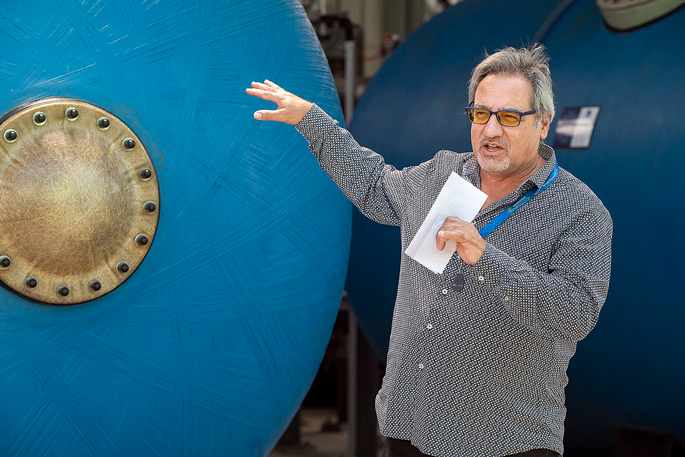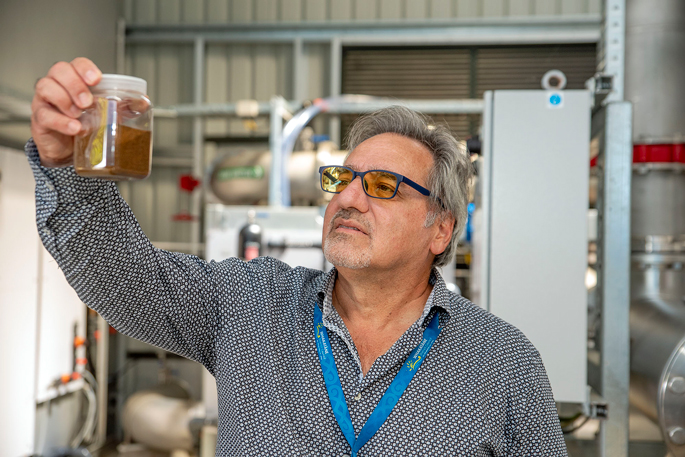The new $6.3 million Braemar water treatment plant was officially opened yesterday, with a blessing and karakia attended by about 100 people.
Braemar Spring, known to mana whenua as Te Wai Ū o Pukemaire, supplies drinking water to communities across the Rangitāiki Plains from the Tarawera River to just outside the Whakatāne township.
In its natural state the water contains small levels of arsenic that put it just on the wrong side of national drinking water standards.
The new facility removes this arsenic and is also capable of treating a larger quantity of water than is currently required by the households and businesses it serves.
Mana whenua iwi, contractors and Whakatāne district councillors and staff gathered for a karakia and blessing by council cultural advisor Pouroto Ngaropo.
 Pouroto Ngaropo blesses the plant, with one of the large, blue tanks that removes the naturally occurring arsenic from the water.
Pouroto Ngaropo blesses the plant, with one of the large, blue tanks that removes the naturally occurring arsenic from the water.
After a short history of the area and the significance it has for iwi living along the Tarawera River, Mr Ngaropo blessed the site, “making it safe for all those who come here”.
Mayor Victor Luca thanked all those involved and gave some background to the project.
He said the Braemar water supply was the second largest of the 11 operated by Whakatāne District Council, beginning in the early 1980s with the construction of a spring enclosure structure, a pump station, a reservoir and a reticulation system west of the Rangitāiki River.
“Over the years the supply area has extended to the outskirts of Whakatāne, including Whakatāne Airport and surrounding properties.”
Dr Luca, whose background is in chemistry, explained a little about what went on with all the pipes, valves, tanks and instrumentation contained in the large shed. He said the arsenic in the water in its natural state was harsh on metals and had a low acidity.
“In more recent years, changes to drinking water compliance standards really put the pressure on us to find the solution to that small concentration of arsenic.”
He explained how the granulated iron oxide hydroxide - brown granules that look like coffee - inside the large blue tanks in the plant were “the trick” that removed the arsenic from the water.
“The materials in these tanks can pick out one or two atoms of arsenic out of a billion molecules of water. The plant is now able to meet the compliance standards and while current demand peaks at around 6500 cubic metres, it has an ability to treat up to 15,000 cubic metres a day.”
The granules needed to be replaced every two years at a cost of around $40,000.
The site also has a new road leading to it and the swimming hole, which is a popular spot for summer picnics. New toilet facilities have also been built.
Two new pou whenua, carved by master carver Kereama Hohua, guard the entrance way to the site.
 Mayor Victor Luca talks about the process of removing naturally occurring arsenic from the water supply and thanks the many contractors and subcontractors who worked on the new plant.
Mayor Victor Luca talks about the process of removing naturally occurring arsenic from the water supply and thanks the many contractors and subcontractors who worked on the new plant.
The project was built using $1.35 million of the $5.6 million stimulus funding package offered by central government to the council to create employment and complete projects after Covid-19 lockdowns.
Council chief executive Steph O’Sullivan acknowleged councillors and staff for their wise decision making in putting Central Government Covid stimulus money toward completing the project.
“Our elected members get a really hard time from the community. You’re hearing it at the moment in the paper and in the letters to the editor. I can tell you that when the $5.6 million of stimulus money came on the table, the staff put a long list of projects in front of councillors and they went through them very carefully to determine what their priorities were at that time for our district. They really wanted to see projects that had been on the books for a long time that we just weren’t able to get under way.
"Councillors really listened to the experienced staff and made their decisions wisely. This project is a good example of that, Something that’s really critical for our community in terms of safe, water."
LDR is local body journalism co-funded by RNZ and NZ On Air.




0 comments
Leave a Comment
You must be logged in to make a comment.